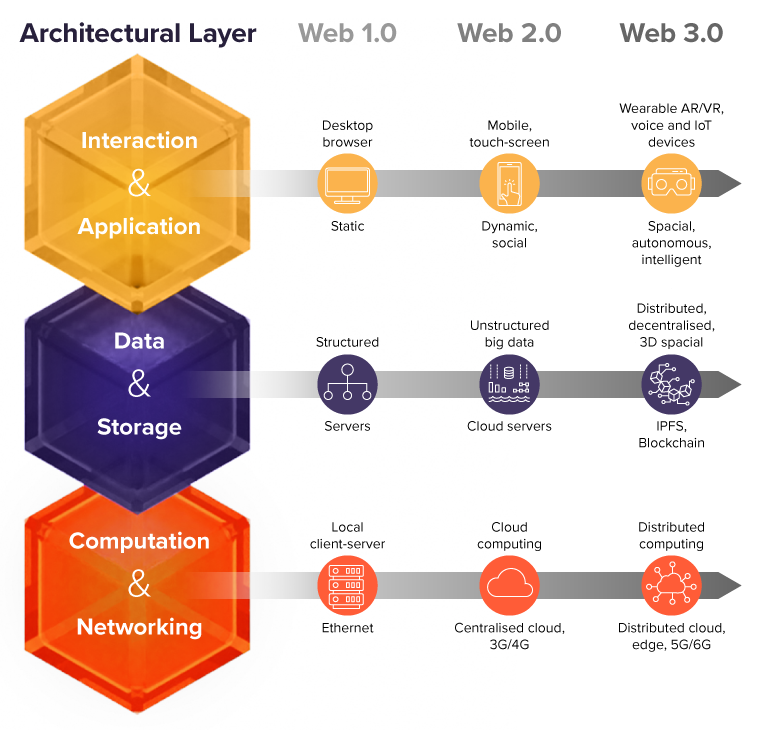Warning: Trying to access array offset on value of type null in /nas/content/live/hadean2022/wp-content/themes/blankslate/functions.php on line 373
In our last blog in this series we discussed the incoming technical challenges that will be facing us as we build the metaverse.
While the gaming industry over the years has continued to push the boundaries of what’s possible in online virtual worlds, we’re currently experiencing a ceiling in technical capabilities. Processing power is limiting the fidelity and scale, while networking challenges have led to worlds maxing out at around 100 participants.
Additionally, different platforms are building the envisaged ‘decentralised’ worlds, but they remain in silos. In order for us to achieve one, interoperable metaverse, we will need to provide a solution that links these worlds together. This will incur a similar range of challenges that web 3.0 infrastructure can address.
In this blog I’d like to focus on the changes in networking that are made possible by edge computing, and how it is already playing a key role in the metaverse and wider web3 structures.

Web 3.0 Technology Stack
(Source: Hadean, adapted from Deloitte, “The Spatial Web and Web 3.0”)
The Networking Challenge Ahead of Us
Real time applications that produce locality based demand are on the rise. IoT devices used in smart factories, cities or homes are only workable through low latency distributed networks that edge can provide. On top of this, we’ve seen global internet usage increase in the wake of the pandemic, with a particular rise of video streaming from both conferencing and entertainment.
In fact, in Gartner’s ‘What We Do and How We Got Here’ report from 2021, they stated that currently around 10% of enterprise-generated data is created and processed outside traditional centralised data centers/clouds. They predict that by 2025, this figure will rise to 75%, noting the key role that edge computing will play.
Disruptions to service have not been uncommon, with many platforms experiencing latency issues and/or complete crashes. The uptake of edge computing, and additionally moving away from single computational architectures to distributed ones is alleviating this problem, but it’s not happening fast enough.
This is particularly problematic given that perhaps the biggest networking challenge yet remains unaccounted for. When we reflect on the vision of the metaverse, we’ve barely scratched the surface of the problem ahead of us.
Last year, Mark Zuckerberg, Meta’s founder and CEO, when speaking on the metaverse said that “creating a true sense of presence in virtual worlds delivered to smart glasses and VR headsets will require massive advances in connectivity.”
He went on to say that the challenge ahead will be “bigger than any of the step changes we’ve seen before,” and that making progress with globally streamed videos and worlds would take completely new make-ups of networks.
Love him or hate him, Zuckerberg’s predictions in this case without a doubt hold truth. The vision of the metaverse will be the greatest leap in what we expect from online digital worlds. With our current, web 2.0 technology however, we’re encountering a number of barriers.
Situation Today
We need only take a look at a few of the key metaverse events of the last few years to see how this technology is restricting our experience. As people began to use games such as Fortnite for things like socialising, they became one of the leading ‘first instances’ of the metaverse. Soon enough, there were events such as concerts planned for these worlds, such as the one featuring Travis Scott. At this particular event, there was a total of 12 million people in attendance – but were they truly all together?

Travis Scott’s Fortnite Concert
(Source: Epic Games)
When managing such a huge number, the concert has to be replicated a number of times, with each replication only containing around 100 participants. If the metaverse is supposed to offer something new and exciting, then having a 100 person cap on virtual worlds is going to seriously hinder this.
And then there’s the more nuanced issues that come with networking in the metaverse. One of which has become known as ‘The Sniper Problem’. Recently, CTO of Epic Games Kim Libreri, spoke on the ‘sniper problem’, which is the issue that arises when you have a long field of view across a virtual world. Generally, when simulating a large area, the world is broken up into a grid format and each cell is processed separately. The issue that occurs with this, is that a person looking down a telescopic sight from one cell needs to see what is happening across many different cells further away from them. Each of these cells may have a separate machine processing the activity within it, which then has to be communicated back to the cell where the person with the sniper is observing.

(Source: Epic Games)
When entering a future metaverse world, it might involve downloading an entire city scale terrain, along with physics, AI and all information around shops, games, venues etc that might inhabit it. On top of this, you have the information of what every other individual is doing, and crucially, the uploading of your own information about your activity.
In short, the data transfer involved with metaverse worlds is massive. Not only would it be a huge strain on computation, but it also involves communicating the actions and positions of thousands of individuals in these worlds without causing high latency.
How We Can Solve This Problem
Localisation through edge computing will be the key to ensuring a stable experience of these worlds. But our current infrastructure is already struggling to provide the sufficient framework for edge computing. As metaverse projects begin to sprout their heads, we’re already seeing the results of this ill preparedness such as servers for virtual concerts being overwhelmed.
We need our networking nodes not just to be close to the client, but also ready to spin up dynamically as activity across the network grows. And crucially, we need interest management to sort through the data and prioritise the most crucial bits.
At Hadean, we’ve developed Hadean Connect to provide the networking for the metaverse. Our solution places nodes on the edge, close to client connections. We’ve achieved never before seen concurrency across a distributed network on a single simulation that scales dynamically to address spikes in demand. It smashes the current limitation of 100 participants imposed by outdated web 2.0 technology and enables thousands of people to come together in more immersive experiences. Within and across virtual worlds, Hadean Connect ensures that they have the sufficient networking needed.
But the technical challenges of the metaverse do not end here. As we’ve seen, the metaverse will involve a huge amount of data. Data that needs processing in an efficient manner and accessible manner such that everyone can access the metaverse. For this, we need to address the computational challenges involved. Stay tuned for the final blog of this series.
